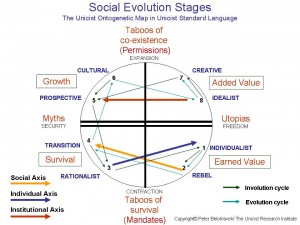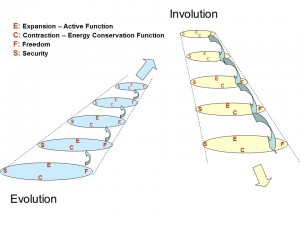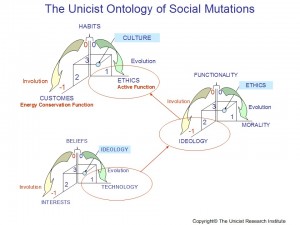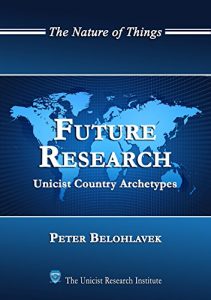Inferring the Future
The management of the laws of evolution allowed developing a future research model that is based on finding the unicist ontological structures of a scenario in the past, and using the data of the present in order to infer the future.
The Unicist Approach to Future Research is based on the research of the unicist ontogenetic intelligence of nature that started at the beginning of the 80’s.
It was a step by step discovery based on the apprehension of the nature of social phenomena entering afterwards in the institutional and individual evolution. Its integration with biology and physics was the final stage that was achieved.
This approach is based on the fact that future and past are not symmetric. This is the case of all the environments that are evolving or involving. The past and the future are only symmetric in stagnated environments.
The objective of the unicist approach to future research is to define a future scenario in order to adapt and influence it.
When an individual “looks back” at the history, the events that occurred are reasonable, understandable and logical. Therefore when approaching the future what is required is having the “logic” that is evident when analyzing the events of the past.
The building of future scenarios is based on the fact that the structure of the unicist ontology of a specific environment needs to be found in the past and that the facts of the present are used to infer the future.
The unicist approach to future research is based on inferring the future based on the laws of evolution established by the ontogenetic intelligence of nature, which allowed developing the unicist ontology of evolution.
This allows building reliable future scenarios.
The Unicist Human Spiral Evolution & Involution
A double dialectical behavior produces necessarily a spiral evolution. The coexistence of both simultaneous dialectics produces an apparent anarchic unpredictable behavior within the credibility and functionality zone.
Both polarities are simultaneous and their instantaneous positions define an influence between the elements that generates a structural position with conjunctural variations.
There are many operational solutions that fulfill the conditions of a given ontology. Therefore, seen from the outside, it might be considered that there is no unique ontology.
The spiral of evolution is driven by the active function (expansion) which proposes a superior conservation principle in order to extend the boundaries of what is the existent purpose towards a higher level. A higher level is a level with more added value to the environment.
To understand this process in human social evolution eight positions have been defined (four ascending and four descending positions) in this evolution process.
They establish three “stable” situations that define four segments that behave in a structural way.
The double dialectical process that produces the double pendulum generates a high level of entropy in each movement.
The higher the level of evolution, the smaller is the amplitude of the pendulum and the lower is the entropy.
Theoretically, evolution could drive towards perfection, where materialistic and non-materialistic reality is one.
At this level reality as it is perceived by humans could not exist.
But this is just hypothetical. Real life includes involution, which occurs when a specific object becomes dysfunctional to the environment.
Thus involution begins including increasing amplitude of the double dialectical pendulum.
This implies increasing entropy between the positions, generating a trend in which the loss of energy that occurs between the polarities generates an involving trend.
Involution drives toward the death of the object, its mutation or its recovery, when it finds a source of energy to compensate the involution trend and begins an evolution cycle.
In any case, it implies a new object with a different energy level with or without mutations.
The Unicist Ontology of Social Mutation
The evolution of a biological entity is produced by “tiny” revolutions that produce small mutations that are integrated in the complex system generating the evolution or involution of this entity. Social environments also evolve based on small mutations.
A social mutation is produced when the functionality of a social entity has been lost, and there is the necessary available energy to generate a change. This can happen based on the persistence of social viruses type “A” that become chronic social diseases, generating a dysfunctional purpose that can be hardly limited by the exertion of power.
This chronic disease of an entity can be produced by inaction or by the continuous use of palliatives to neutralize its crises.
The mutation is produced by the appearance of a strange attractor that generates a change of the chaos, transforming it into a new and different functional behavior.
The strange attractor generates an unpredictable new order that exceeds the possibilities of the power to control it and mutates the existing chaotic credibility zone towards a different functionality. That is why mutations cannot occur in entities that are managed based on the exertion of absolute power.
This strange attractor disappears as such and evolves into an object as soon as the new credibility zone begins to exist.
This process can be understood by comparing, at the end of the first decade of the XXI Century, the evolution of the European Communist Countries and the evolution of Communist China.
Social strange attractors are social objects that have a lower ethics when the situation mutates towards a more instinctive and individualistic behavior.
Strange attractors generate evolution when they are objects that integrate a driver and catalyzing and gravitational aspects. In this case, they become fully unstable but conjuncturally functional, because catalysts and gravitational aspects cannot be part of a system.
It has to be considered that strange attractors disappear as such and are replaced by an object that is homologous to their driver as soon as the entity has mutated.
This new object generates the necessary complementary and supplementary functions in the environment using the energy generated by the dissolution of the original object.
The result of social mutations is unpredictable. All what can be predicted is the trend towards evolution or involution.
If this process includes the participation of change agents, they are excluded in the case of involutions and eliminated in the case of evolutions.
Strange attractors are defined by the change of the technology that sustains the ideology on which the social entity and its environment are based. The dysfunctionality of the existing technology is what generates the chaotic situation that requires the use of power in order to control it. The concept “technology” needs to be apprehended in the wide sense, meaning different ways, hard and soft, to improve the functionality of something.
The introduction of a new technology maximizes the existing chaos and generates the possibility of the appearance of the new strange attractor.
If the strange attractor does not appear, the chaotic entity explodes or implodes depending on the characteristics of the context. If it appears, the entity evolves or involves depending on the characteristics of the strange attractor.
Conclusions
From an operational point of view both evolution and involution appear to have a linear behavior.
On the one hand, the effects of evolution appear to be linear since there is always a better energy optimization complementation level with the environment.
On the other hand, the effect of involution also appears to be linear, providing an increase of entropy produced by the growing amplitude of the pendular behavior.
Social involution is sustained by the building of fallacious myths in order to avoid the disintegration of the restricted context of a given reality.
Fallacious myths provide both a myth to function and a utopia to believe in. But the integration of both is hypothetical and not real. Therefore they work as a social integrator but at the same time as an involution driver.
It has to be considered that those who do not share their fallacious myths cannot be part of a culture. Involution ends when reality has been accepted, the losses of the process have been taken, and a new utopia appears.
Peter Belohlavek
The Unicist Research Institute






